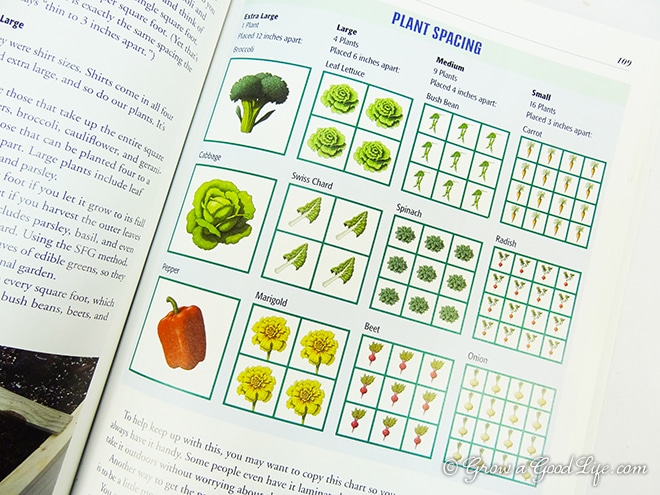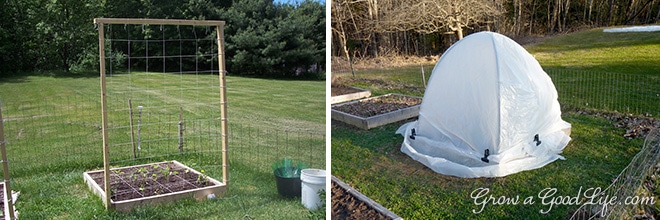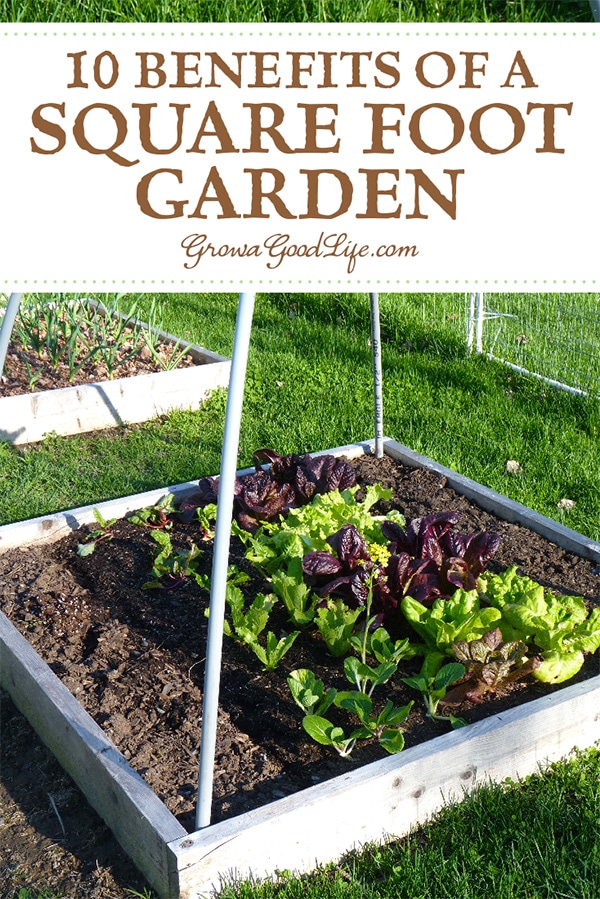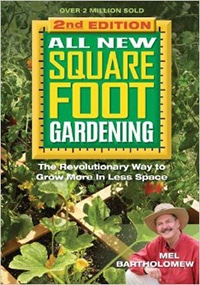10 Benefits of a Square Foot Garden
This post may contain affiliate links, which means that I may receive a commission if you make a purchase using these links. As an Amazon Associate I earn from qualifying purchases.
If you are just starting a garden or want to expand your growing space, the Square Foot Gardening method is worth considering. The beds are easy to build with no digging or tilling required.
 I grew up in a small town where my parents and extended family tended several vegetable gardens on our property. Each spring, the gardens were layered with manure delivered by a local farmer, and tilled into the native soil. Then the soil was raked and planted with long rows of vegetables.
I grew up in a small town where my parents and extended family tended several vegetable gardens on our property. Each spring, the gardens were layered with manure delivered by a local farmer, and tilled into the native soil. Then the soil was raked and planted with long rows of vegetables.
My grandparents and great aunt did most of the work in the gardens over the growing season. As a child, I remembered that involved a lot of weeding and hoeing, weeding and hoeing. They probably enjoyed working in the garden each day, but to me it seemed like a chore.
When I purchased my home, I was thrilled that it came with a small vegetable garden bed. I dreamed of growing a garden like my grandparents did, filling the freezers and pantry with homegrown vegetables.
The first year wasn’t stellar. The garden beds were infested with weeds, the soil was in poor shape, and I quickly discovered that I didn’t have enough time to weed and hoe each day. The good news was that even with the challenges I was able to harvest enough veggies to feed us. I was optimistic by what I could grow and I knew I could get more yields for my efforts if my veggies didn’t have to battle the weeds for water and nutrients. I had to do something different.
Over the winter of 2009 I began reading All New Square Foot Gardening by Mel Bartholomew. I decided to test the square foot gardening method out by adding three 4×4 square foot beds to the south end of our garden area. We built, filled, and planted these beds in just a weekend.
You can see the details of the building process here: How to Build a Square Foot Garden. The vegetables planted in these beds did very well.
What is Square Foot Gardening?
The square foot garden model was developed by Mel Bartholomew and explained in the book, All New Square Foot Gardening originally published in 1981. The book has been updated several times over the years with revised information and additional projects to enhance your square foot garden. Since it works so well, the original concept of square foot gardening remains the same.
The basic concept of square foot gardening involves building a small garden bed out of 2×6 inch boards, filling the bed with a soil blend called Mel’s Mix, dividing the bed into one-foot sections, and planting each square according to the plant spacing described in the book.
The square foot gardening method continues to be a popular way to grow an intensive vegetable garden in less space and with less work.

10 Benefits of the Square Foot Garden Method
I loved gardening in our newly built square foot garden beds so much that I added more when I extended the garden over the years. They continue to be a great way to garden and are easy to build making it so quick and easy to expand the garden area.
Some of the benefits to square foot gardening:
Quick Setup: Square foot gardening is a quick way to start a new garden or expand a garden. Once you have gathered your material, you can build, fill, and start planting the same day.
Easy to Plan: The square foot gardening concept is simple and organized. Since the beds are divided into squares, it is easy to plot your growing beds according to the charts in the book.
No Digging: You don’t have to worry about digging a garden because the raised beds are placed on top of the ground eliminating the need to dig or till a garden. The grass decomposes naturally beneath the bed.
Start with Healthy Soil: Building raised beds and filling with quality soil gives you an immediate advantage over a regular garden because you are starting out with soil that is rich in nutrients and organic matter.
No Soil Compaction: Since you never walk on the beds, the soil stays loose and is able to hold water, provide oxygen to the plant roots, and maintain a flourishing microbiological environment that is ideal for plant growth.
Warmer soil: The soil in raised beds drains and warms quicker in spring allowing you to start planting spring greens sooner. In addition, heat-loving plants such as eggplant, peppers, and tomatoes prefer a warm soil so they will flourish in raised beds.
Less Weeding: Since you are starting with fresh soil, there are fewer weeds for the first few years. Intensive planting also shades the soil and helps prevent weeds from growing. Weed seeds do blow in over time, but they are easy to manage. Weeds pull out easily since the soil is fluffy and loose.
Easy to Water: Since the beds are small, it is easy to provide moisture to the crops and not waste water by watering the paths or rows in between. The soil mix absorbs and holds water. The close spacing also helps shade the soil preventing moisture loss.
Greater Yield: Growing in raised beds with healthy, nutritious soil allows you to plant closer. Since there are no paths between rows, there is no wasted space. This intensive planting results in a greater yield from your square foot garden than regular garden space.
Easy Upkeep: Just like all living things, soil needs to be fed in order to provide a healthy environment to grow your vegetables. Simply adding organic matter each year will maintain the texture of your soil and replenish nutrients.
Adding a trellis to the north side of the bed allows you to grow vining crops such as pole beans, indeterminate tomatoes, or cucumbers. Crisscross two 10-foot pieces of PVC and you have a dome that you can drape with plastic for some frost protection, deer netting to keep critters out, or row covers to keep insects off the plants.

Over the years, the garden has expanded to include additional raised beds. Adding fresh compost each year has helps maintain the soil’s fertility. Although there were minimal weeds in the beginning, over time a few began to pop up. But they are much easier to control than my other beds.
I still use the recommended Square Foot Gardening plant spacing in most of my raised beds. Some have been adjusted over the years to accommodate my growing conditions or the varieties of plants I grow. The garden is an ever evolving and ever growing process, but it was encouraging to have a fresh start.
If you are just starting a garden or want to expand your growing space, the Square Foot Gardening method is worth considering. The beds are easy to build with no digging or tilling required.
This article was originally published on April 3, 2013. It has been updated with additional information, photos, and video.
More Gardening Articles:
- How to Build a Square Foot Garden
- 7 Tips for a Low Maintenance Vegetable Garden
- Planning Your Vegetable Garden: Mapping the Garden Beds
- How to Make Your Own Seed Mats or Seed Tapes
- How to Harden Off Seedings



Rachel, I am considering converting my existing garden bed (30×10) into a square foot layout. I will not be making it into a raised bed, but I do plan on adding the suggested soil mix and having it tilled into the dirt. Any suggsstions for success?
Thank you for sharing at Green Thumb Thursday – hope to see you tomorrow! I pinned this to my Children’s Garden/Homesteading board – this is such as simple method of gardening and we need to inspire the next generation!
Thank you for sharing at Green Thumb Thursday and we hope you’ll come back tomorrow and share some more! Square Foot Gardening really is such a great foundation!
Great article Rachel! Mel’s methods have done a lot to encourage so many folks to take up gardening. I learned a lot from James Crockett back in the 70s when I first started gardening. I still refer to his book from time to time. I also get a lot out of The Vegetable Gardener’s Bible by Edward C. Smith. He is a fan of wide rows, raised bed and deep soil prep.
Dave, I love gardening books. They help me get through the long winter. I also own The Vegetable Gardener’s Bible too. I like trying out different ideas and methods and figuring out what works for my garden.
I have been seeing photos of square foot gardens online using cement blocks instead of wood framing – then you can plant in the little holes in the blocks as well. I’m wondering if you know anything about the pros and cons of cement blocks vs wood?
Zendelle, I have seen raised beds built from cement blocks too but I haven’t used them myself. The pros would be the cement wouldn’t rot. We need to replace a lot of our wooden raised bed frames this year. The pine boards we used lasted about five years. Concrete blocks would last forever. Cement also absorbs heat. This could be a good or bad thing depending on your climate. The bed will need some extra water during hot periods.
We also found the planting guides in the back of the book for succession gardening to be very helpful. But that Mel guy has a pretty funny writing style.
Connie, I agree, the writing is a little rough but I forgive the author because he is an engineer not a writer. He repeats the information enough throughout the book so you understand the basic concept. The planting guides are helpful.
I love the look of square foot gardens. I may set aside a spot in my garden for a few square raised beds. I try not to dig up any soil whenever I build raised beds. putting in a good layer of grass clippings and leaf mold followed by a good soil mix from a local company seems to do the trick for me.
Thomas, A good soil mix is the best way to start a raised bed. My beds are amended with compost each year, so the original Mel’s Mix is diluted but it was a good way to start in the beginning. There were very little weeds in the first few years and it is still easy to keep up with them now.
I was motivated to start a garden after reading Mel’s Squar Food Garden book, I didn’t follow his instructions, but the idea of planting a small square at a time is enough to get me started growing “something”.
Mac, That’s why I still like the Square Foot Gardening method to this day. It allows you to break down the whole gardening process systematically. Instead of focusing on the whole garden at a time, you can narrow your tasks down to one bed at a time or even one square at a time.
My bible has always been How to Grow More Vegetables by Jeavons. Like Mel Bartholomew he does wide beds and block plants as opposed to planting in rows. Though a lot of Jeavons ideas don’t translate to an urban or suburban yard (like growing for your carbon needs, when we have tons of leaves for the taking without intentionally growing them), but I like his spacing a bit more than Mel’s. Both are good reads though.
Daphne, I like John Jeavons’ Biointensive methods too especially for growing potatoes. I use a little of both in my garden now but the Square Foot Gardening method is the one that got me rolling.
We battle the weeds by using weed control fabric – it’s amazing how much time and effort it has saved.
Sue, I am a devoted fan of weed control fabric. It took several years, but between the weed control fabric and adding compost, the in ground beds are in pretty good condition now. It was helpful to have the square foot garden beds pretty much trouble free so I could concentrate on weeding and improving the soil in the in ground beds.